That day, I had Mom to drop me at the main jetty in the capital city. Already, some staff members were standing in wait for the boat. The view was refreshing with Istana Nurul Iman basking in the glorious morning rays, the authentically-Bruneian Kampung Ayer houses cluttered by the riverbanks with a greenish-domed mosque standing out amongst them and the mangroves filling up the spaces in between.
It was the season of durians as bags of them were loaded onto or from the boats. Speaking of durians, I smelled durians all along Jalan Tungku Link on my way home from work because I was somewhere behind a pickup with a loadful of durians! What an experience, hahaha!
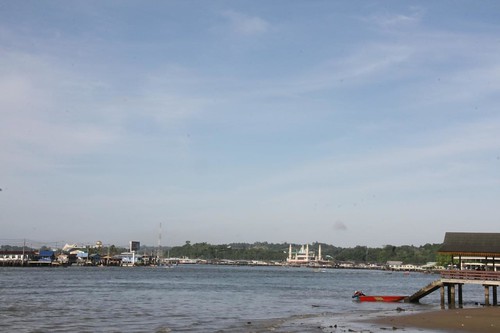
Boatman unloading a sack of durians
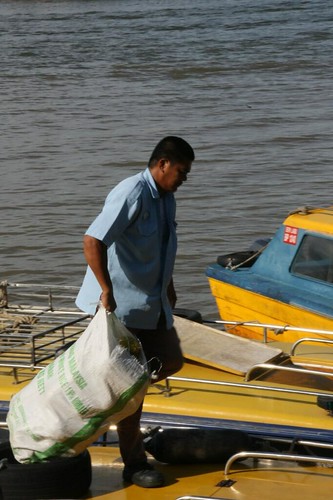
Solar-powered warning lights by the jetty to signal drivers to slow down for pedestrians at the zebra-crossing
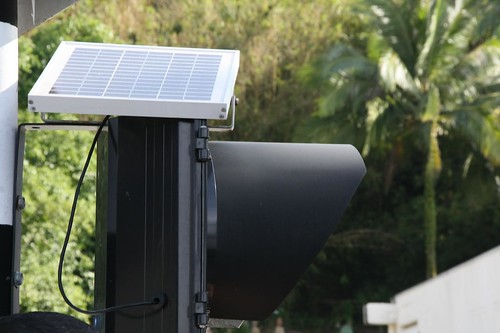
More sacks of durians waiting to be unloaded
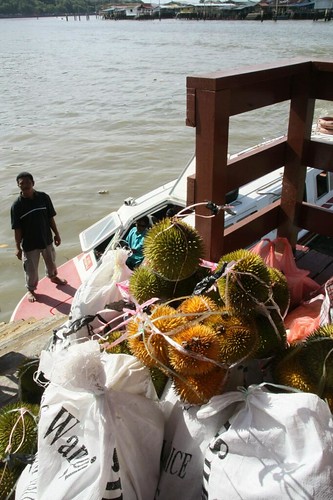
A wooden house not far from the Bangar jetty
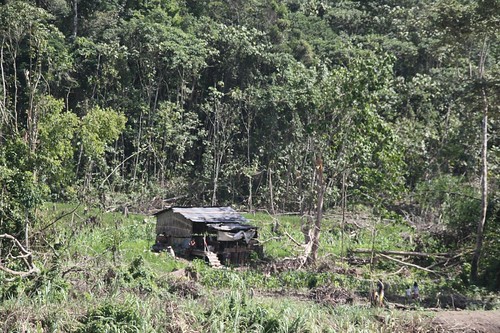
Someone tripped and fell on his way out of the bus. He got his ankle twisted but thank God, he managed to recover for the hikes. In fact, we had such a great time! So, this is a picture taken right after the fall. Thank God, someone brought some ointment and was applying some on his foot to relieve the pain.
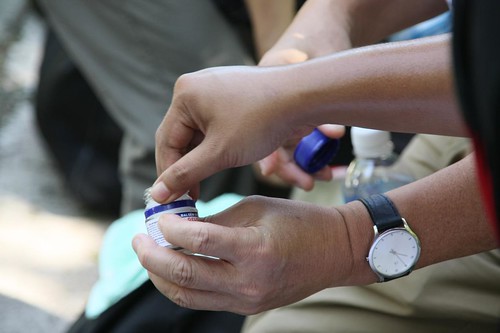
The Brunei Times - Feature
Not so far away from madding crowd
The Brunei Times
Sunday, October 18, 2009
Nasroul Hizam again heads to Temburong. This time exploring the nature in its purest and most opulent form in the company of professors and students of Universiti Brunei Darussalam’s (UBD) Faculty of Science for a real “rainforest experience”
Rainforest Diaries:
Day One
I was pretty much pumped up to be headed to Temburong. There's just something about escaping the throngs of people, concrete buildings and traffic jams which I secretly look forward to. You always hear about tourists (even locals) who venture into the Ulu Belalong National Park and having a blast. This time, I was with a different crowd, the learned type. I joined a group of 13 lecturers and two undergraduates from Universiti Brunei Darussalam's (UBD) Faculty of Science for a “rainforest experience” weekend. For most of them, it was their very first time in the district. For me, it would be the very first time ever staying overnight in Temburong. And an even rarer opportunity was to stay at the Kuala Belalong Field Studies Centre (KBFSC), a centre closed off to tourists except during UBD-organised trips or its own programmes for secondary school students which typically take place on the weekends during school holidays.
This trip was different from the rest since I was dealing with lecturers and researchers, experts in their respective fields. While some discussed ecological systems, others were greatly fascinated by the flora and fauna, rock sediments and even material structures. It made for some very interesting observations and conversations.
In the past, visits to the district have been strictly a day affair. The most is I would have taken the last boat back to Bandar Seri Begawan and the least is driving through it on a road trip to Kota Kinabalu. This opportunity was epic and some might wonder how on earth I would survive.
Upon arrival to our destination, Outward Bound Brunei Darussalam Batang Duri Camp jetty, I literally got off on the wrong foot. I embarrassingly slipped and twisted my ankle as I was leaving the bus. Immediately I thought, “Is this the end? Just when the experience was about to begin?” Fortunately, it was nothing major and after putting pressure off it, I was ready to roll, albeit slightly hobbling along at a slower pace than my youthful vigour would normally allow me to be. That was when I wished I had mastered the art of packing light.
We got to the KBFSC 15 minutes later by temuai (longboat). Made up of a number of interconnected chalet-styled rooms, the whole centre can comfortably accommodate over 100 inhabitants in its rooms. Complete with bathroom facilities and limited electricity delivered by a diesel-powered generator from 4.30pm to 11pm, one can see how researchers could comfortably stay here while conducting their studies.
After a brief look at the centre, the group proceeded to one of Temburong’s pride and joy, the Canopy Walk. Nursing my bruised ego, I managed to be the fifth person to make it to the canopy tower, 385 metres away from the Temburong River. Recovering from my earlier emasculation, I braved myself to climb the canopy towers. For someone who could barely change curtains on a stepladder for Hari Raya due to a fear of heights, it was good practice for facing my fears. Naturally, I didn't look down. It was also then that I realised my phone could get a signal!
As I stood by the treetops and surveyed my surroundings, sure that I might as well try to reach for the clouds, nature in all its opulence stared right back at me with its different shades of jade and emerald green. No words could possibly describe how minuscule a human being would feel surrounded by such magnificence.
The trek back down wasn't as tiring. Although going up needed stamina, this time required technique and skill. I had half a mind to curl myself into a ball and simply roll downhill to save myself the trouble but the thought of many other possible injuries put me off it. Very wise decision, I think. Our next destination in the itinerary was the Apan Waterfall but we had to first drop off our bags and other belongings for fear whatever beloved electronic equipment we brought would fizzle away into nothingness.
However, it had started to drizzle and our plans went down the drain. Our guide, Field Supervisor Rodzay Hj Abd Wahab postponed our waterfall frolicking to tomorrow, promising that the water would be plentiful due to the downpour.
A few minutes later, the rain came down a lot harder. But then I shouldn't be surprised. It’s not called a rainforest for nothing.
Day Two
First thing in the morning, seven of us prepared to take off to the almost 3km Ashton Trail, which surrounds a 25-hectare research plot near the KBFSC.
Braving the previous day's injury, I had my ankle wrapped and supported and trekked on with the rest. The vegetation was similar but this area packed a bigger punch. With the forest floor littered with dead leaves and yesterday's heavy rain, every step had to be carefully calculated. Being the non-mathematician, I found myself sliding down a few steep slopes. Fortunately, I was far from the deep gorge and various gulleys that lay in wait. But not without a scratch here and a graze there to show for it. More often than not, we had to develop cat-like reflexes and acrobatic balance to save ourselves from very dangerous falls.
Our guide showed us trees and plants that Bruneians have traditionally used for medicine and even poisons used by indigenous groups to hunt. There were some very interesting ones too such as various vines that make use of clever techniques to grow and survive before killing their host trees. A very morbid thought but as Sir Elton John sang it, “that's the circle of life”. Some of us even began devising business plans based on nature's cut-throat survival techniques.
One thing I did notice was that the creatures in the rainforest were significantly larger, if not almost gigantic in proportion to those normally found back home. Ants, millipedes and moths alike seemed have taken some animal steroids humans have yet to discover. Following the advice of our guide, we were as quiet as a group of seven visitors trudging through the forest could possibly be. We didn't want to ruin the chance of coming across animals such as deer or hornbills which frequent the area. However, we were also on the alert for leeches which we eventually did find. They attached themselves to fallen leaves, standing in the air in the hopes of latching onto an unsuspecting mammal.
After hours of climbing and walking, we managed to reach back to the KBFSC an hour ahead of schedule, which could be considered an amazing feat. All I can say is “Bukit Shahbandar, eat your heart out!”. I have discovered a new respect and admiration for scientists and researchers who have had to brave those hills in search of samples. It would be hard to imagine manoeuvring with equipment strapped to our backs or loads of sample to return with. A participating lecturer said that it was much more challenging than writing a computer programme. And although everyone agreed it was strenous, one just has to wonder how difficult is it exactly to construct a programme these days.
Muddied and exhausted, with some nursing bruises, we returned in time for lunch and awaited the next item on the to-do list, Apan Waterfall.
Last night's rain apparently only fell in the lower part of the river so there wasn’t much difference in the water volume nor flow. All the same, we headed off by temuai. It was a 10-minute walk from the river. Earlier in the morning, mud and damp fallen folliage were dangerous. This time, loose pebbles and slippery rock surfaces were something we had to watch out for. I doubted my body would last very long slamming into a solid geological structure, especially if they were sufficiently sharp-edged.
The waterfall itself was a tiny gem, tucked away in the wilderness. Still in our lifejackets, we could swim about in the little lagoon. The crashing of the water on my body was highly therapeutic, almost like a natural jacuzzi beating down on me. However, we did have to be careful of rocky bits that we could easily bump into.
Reaching the waterfall was the easy part. Getting back basically required us to move backwards, especially with climbing down a particular rockface. I would have to say that my previous rockclimbing experience sure came in handy. I made a promise then to make it a more regular activity.
When we got back to the riverbank, our guides asked if any of us wanted to float down the river instead of heading straight back to the KBFSC by temuai. Including myself, three others raised our hands eagerly. How often does one get to ride the currents freely? Of course frantically flailing to dodge rocks while drifting the distance of 500m felt like the embodiment of “going with the flow”.
It was 4pm by the time we decided to get out of the water. It was a mixture of being calmed by the river and the cooling effect of the water on our tired physiques that reduced us to playful water nymphs. There were some, on the other hand, who accidentally did field testing of rock surfaces with their knees and toes.
The rain came sooner this time and it came down mercilessly hard. The rest of the night then just faded away in discussions of the past two days' experience.
The forest also accompanied us on our final night at the KBFSC. Like the night before, nature’s symphony of bird calls and cicada chirps filled the cool air.
I could see why tourists fly all the way here to get in touch with nature. The colours, sounds and even the emotions that come with being immersed in it cannot be replicated exactly by any other technology. Listening to recordings of nature on Youtube cannot compare to actually listening to it in person. You would have to be present yourself to know how cool a river is or how pleasing it is to discover a fascinating creature live.
Day Three
Two straight nights of rain had successfully raised the water levels in the Temburong River. It looked as if it went up by over a foot or two. In the morning, the temuai ride back to the Outward Bound Brunei Darussalam Batang Duri Camp jetty where our bus was waiting was comparatively smoother than when we arrived. The strong current added with the boat cutting through the river made for some very unexpected splashes that were sure to keep a drowsy passenger wide awake.
Before reaching Bangar town, we stopped by the Batang Duri Park, a mini zoo visible from the Batang Duri road. Perhaps it was because it was a Sunday so the two sunbears really couldn't be bothered to be excited about their visitors. Out of a herd of deer, a single one broke out and approached us. We were confident that it thought we were about to come into the cage with food. Other animals included crows, herons, eagles, pheasants and a very agitated weasel.
Looking around, it seemed as if the place needs a lot more attention from the Department of Environment, Recreation in order for it to be a proper tourist spot. There is plenty of room for improvement, it would surely keep the authorities busy if they are serious about bringing in tourists into the district.
We're already on the way back and you could see how everybody felt the weekend had been spent productively and fulfillingly. I was disappointed that the trip was over. Despite how being completely cut off from civilisation almost made time go by ever so slowly, I believe that is what the modern world is missing out. The lack of communication technology or rather the signal that makes it possible made everybody a lot more social and bonds were created a lot faster and more effectively.
In this fast-paced globalised world, everyone is out in a rush to be as productive as possible and make the most of their time. Very few would stop to appreciate what the world has to offer. It may be uncomfortable and messy but the truth is that there is a priceless beauty right here under our noses. We simply need to take a break from it all and succumb to the healing powers of nature. With climate change and various environmental threats at our doorstep, how much longer do we have to enjoy it all? Or would our future selves be satisfied by looking at photos and videos of what was and never will be?
I take my hat off to the researchers who stop by the KBFSC to conduct their studies. Their work means adding even more value to the rainforest, fighting for the survivals of numerous species of plants and animals. Who knows what treasures lay growing on our beloved land.
1 comment:
The Brunei River photo appears as though the place has not change at all since more than a decade ago. I'm sure things must be very different now and i hope to go back visit soon.
Post a Comment